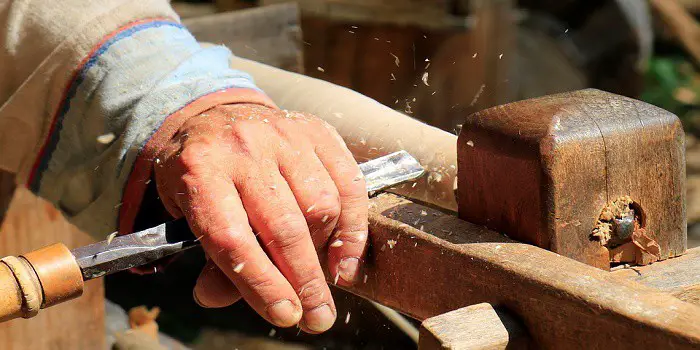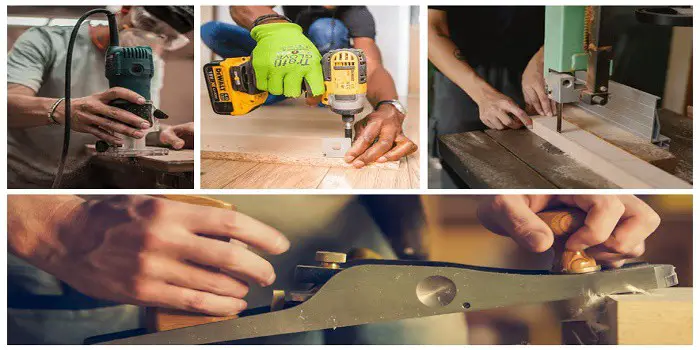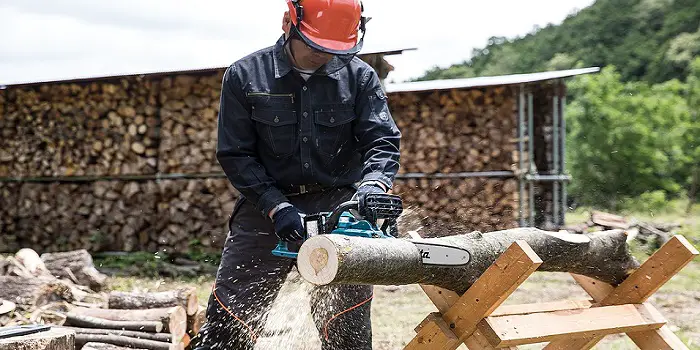
If you are tired of paying for firewood, you can use your chainsaw to create some of your own.
There is a certain feeling of satisfaction when you cut your own wood for the fire.
Using a chainsaw is a fast, simple means of cutting all the wood you need while helping to sustain the forests.
Steps to Cutting Your Own Logs Using a Chainsaw
You will be saving good time and energy when using a chainsaw for cutting logs.
However, for doing so, you will need to get some protection and the right equipment.
Step 1 – Select the Right Tool
You will need to decide which type of chainsaw is right for you, gas-powered or electric.
To determine the right size, you will need to know the type of trunks you expect to cut, the condition of the environment from which you will gather the wood, and the experience you have in cutting wood with a chainsaw.
There is also the budget you have available to purchase a chainsaw.
For the most part, an electric chainsaw is just as good as a gas-powered one.
The only notable advantage of a gas-powered chainsaw is when there is no electricity nearby. Then, a gas-powered version is desirable.
Step 2 – Protection
To properly operate a chainsaw, you will need to have the proper protection.
This means obtaining the following items.
- Helmet
- Eye and Ear Protection
- Gloves
- Chainsaw Chaps
This provides full-body protection from any splinters that might penetrate the skin or eyes.
Step 3 – Getting Started
Now that you have everything ready, the next step is dividing up the trunk into parts so you can easily saw them apart.
When you make the marks to divide the trunk into sections, this can save you a lot of time when cutting.
Do the measurements first, and then make the cut.
Step 4 – Using the Ground or a Support
Where you set the trunk is important and will decide the method you use for cutting.
If you are going to use the ground, be sure there is a wedge present to keep the trunk from rolling away.
A word of warning – Do not cut into the ground as this may damage the chain.
To get started with this method you will need to do the following.
- Start up the chainsaw and set it for a slow speed
- Place the chainsaw over the mark you made for cutting
- Saw about three-quarters of the way through
- Repeat that depth for every marked line
- Roll the trunk over 180 degrees
- Finish the cuts for all the marks
Support will stabilize the trunks better. If you are going to use support, you can create one from a larger trunk by cutting a V-shaped groove.
Set the smaller trunks inside and repeat the same method as if you were cutting on the ground.
Step 5 – Using a Log Jack
Sometimes called “cant hooks” or log lifters, a log jack will let you turn the heavier logs easier while cutting with a chainsaw.
Plus, with a log jack, you can easily hold the logs off the ground so you can make a clean cut entirely through the log without having it strike the ground. It will also prevent the bar from binding as well.
Step 6 – Splitting the Wood
After the first cuts are made into the trunk, you will probably make some smaller cuts afterward to create firewood.
It also allows the wood to dry out faster. You can split the wood by sawing it through its length.
It is best not to split it all with the chainsaw, but rather to make a two to three-inch cut and then use a splitting wedge to do the rest.
Step 7 – Maintain Your Chainsaw
The logs have been cut, so now is the time to clean the chainsaw.
What follows are a few tips that will help keep your chainsaw working properly.
- Sharpen the teeth and maintain the tension
- Ensure shields and guards are properly fastened
- Use recommended fuel and ratios
Remember, a chainsaw that goes dull can be quite dangerous.
This is because the wood can catch and create kickback. Plus, this will toss the bar of the chainsaw back up at you.
By sharpening the teeth of the chainsaw on regular basis, you cut down the chances that it will kick back.
How big of a chainsaw do I need to cut?
Typically, you will require to choose a chainsaw with a bar that is two inches longer than the diameter of the wood log you need to cut.
For example, if you need to safely cut a log that is 10” across, you will need a chainsaw of 12”.
And similarly, if you need to cut a 14 inches tree in one pass then a 16 inches guide bar will be ideal.
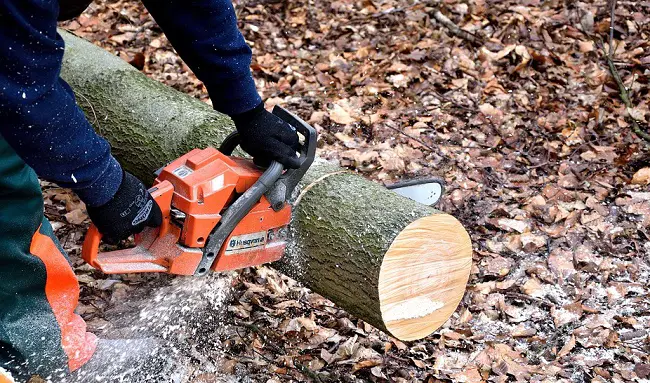
Types of Chainsaws You Can Use for Cutting
Chainsaws for cutting logs and tree trunks come in various different types, sizes, and colors. Each of them is loaded with advanced features and has its own pros and cons.
Some of the most common types, for both homeowners as well as professional users, include:
1. Gas Powered
Gas-powered chainsaws are the oldest version that is also the most commonly used because of their excellent power, portability, and longer cutting times.
These are known for their unmatched cutting performance and speed. But at a cost of loud noise, heavyweight, and more maintenance.
Generally, there are two designs available that are top handle and the rear handle.
The rear handle offers more control over the chainsaw while standing on the ground, and is good for both professional and non-professional use.
Top-handle chainsaws on the other hand are for professional tree cutters as they allow cutting trees at tall heights.
2. Electric Corded Saw
These types of chainsaws operate with inbuilt electrical motors and require a power outlet to run.
That’s the reason these are not very portable.
But if you want a relatively lightweight, easier-to-operate, quieter, and cheaper version you can go with it as long as you are OK to work near the power source.
3. Battery Operated
Battery-powered chainsaws are getting much more popular in recent times due to their ease of use, portability, and low maintenance.
Unlike gas chainsaws, they do not need any fuel to operate and are very quiet. Also, they come with a wide range of bar and chain lengths (about 8 to 18 inches).
The only downside is the type of lithium-ion batteries they use – which makes them expensive compared to other types.
Moreover, they need to be recharged and are not suitable for projects that need a longer time to complete.
4. Pole Saw
It’s basically a type of chainsaw that is attached to a long pole or a stick.
Pole saw is an inexpensive lightweight version that allows you to reach and cut at heights like when pruning the limbs and cutting off tree branches.
Since it offers limited functionality, I recommend getting it as a secondary chainsaw in addition to a primary gas-powered version.
5. Manual Chainsaw
It’s the oldest one that existed even before the gasoline chainsaws.
But they are not very common these days because you will need to do all the hectic work with your hands and arms instead of the engine or a motor.
Manual chainsaws are basically a chain with two handles on either side.
The shorter version can be operated by one person but to operate the longer ones you will require at least two people.
Although not very common, they can still be a great choice for homeowners who do not want to invest in expensive versions for cutting their firewood or trimming trees.
Since these handheld portable saws are very lightweight, economical, and convenient they are also a great option for survivalists’ travel kits.
6. Pneumatic Chainsaw
These are more powerful than gas chainsaws and are more suitable for industrial settings.
In addition to cutting wood, you can use them for making straight cuts in metal and concrete.
Since they are meant for industrial cutting jobs and not designed for beginners, they are often very expensive.
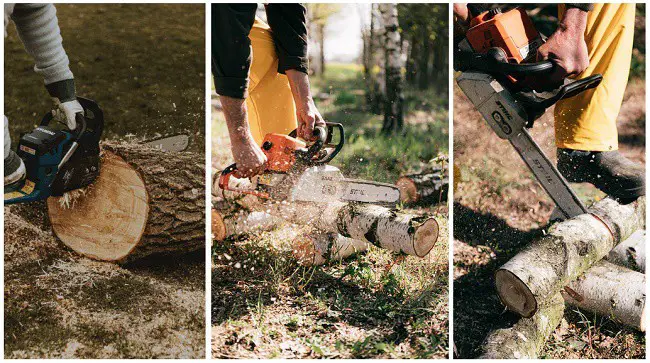
Chainsaw vs. Reciprocating Saw. Which is Better?
If you believe that a chainsaw is the only type of saw that you can use for cutting logs, branches, and trees, you are wrong.
A Reciprocating saw is a kind of saw that many people use and it’s found to be much more efficient than a chainsaw in many cases.
Put simply, a reciprocating saw could be a better option when you want to prune smaller trees and branches.
If you need to cut larger wood pieces, tree trunks, and logs without caring about the noise and the level of neatness, then using a chainsaw is the best choice.
A chainsaw is designed to cut through larger wood pieces and is much easier to work for longer periods of time.
But because of its unique design, the reciprocating saw offers many additional advantages over chainsaws – when it comes to smaller cutting jobs like cutting down saplings, trimming hedges, and pruning away small branches from trees.
Depending on the size of the reciprocating saw’s blade and the power of the motor, you can sharply cut up to 6 to 8 inches thick with considerably less noise.
However, some reciprocating saws with higher torque can also cut up to one foot or twelve inches in diameter.
| Chainsaw | Reciprocating Saw |
|---|---|
| Fast, powerful, and loud | Slow at cutting with less noise |
| Can be used to cut huge trees and logs | Suitable for pruning bushes and branches |
| Cuts leaving rough-cut surfaces | Cuts with better finish and preciseness |
| Two-hand operation and need proper skills | Can be easily and safely operated with one hand |
Things to Keep in Mind when Cutting the Tree Logs
Before getting started, it pays to know a few tips about cutting wood using a chainsaw.
The following tips will help you cut the right way and at the right time.
a) Time of Year
It is best to let the firewood season before you put it into the fire. This means that the wood needs to be cut at least six months before it can be used in your stove or fireplace.
Burning unseasoned wood is more difficult because of the moisture that is still present. Plus, the wood will generate considerably more smoke.
Cutting the wood in the early spring is the best time of the year. That way, it will have six months before you will need to use it for firewood.
b) Is it Legal
You can cut down trees on your own property. But where else can you get the firewood needed?
The answer starts with national forests that will let you cut down trees if you get a permit first.
Remember that you can only cut them down for personal use and cannot sell them.
c) Measure, then cut
In other words, the firewood you cut should be short enough to fit into the fireplace or stove.
Measure it first to ensure that it will fit and then cut along the lines.
Having one pre-cut log for measurement can save you a considerable amount of time.
Moreover, if you follow all the above tips carefully, you can effectively use your chainsaw to cut wood.
Final Thoughts
Holding the logs right and cutting them using a chainsaw isn’t very complex if you know the process well.
Particularly if you are cutting the wood in the forest (rather than pruning your backyard garden trees), you should be careful and follow all the local laws.
And remember, since there are various kinds of saws in the market, make sure you choose the right type of chainsaw for your job that can make your work easier.

Hi, I am Mark Garner a professional carpenter, woodworker, and DIY painter. I live in the small city of Peoria, Arizona as a semi-retired woodworker. I have started this blog with a simple motive to help you with my wood experience in this sector. If you like to know more about what I love doing and how it all got started, you can check more about me here.


